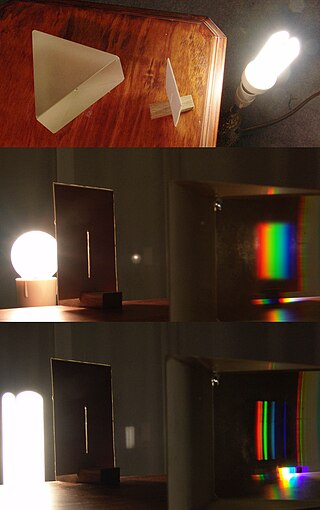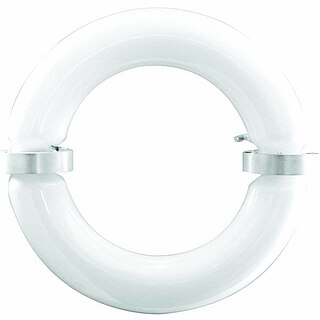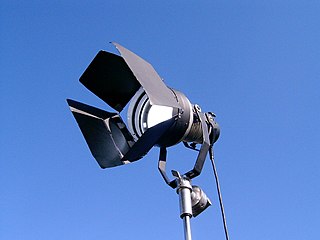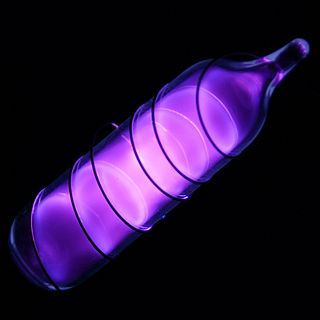
A fluorescent lamp, or fluorescent tube, is a low-pressure mercury-vapor gas-discharge lamp that uses fluorescence to produce visible light. An electric current in the gas excites mercury vapor, which produces short-wave ultraviolet light that then causes a phosphor coating on the inside of the lamp to glow. A fluorescent lamp converts electrical energy into useful light much more efficiently than an incandescent lamp. The typical luminous efficacy of fluorescent lighting systems is 50–100 lumens per watt, several times the efficacy of incandescent bulbs with comparable light output. For comparison, the luminous efficacy of an incandescent bulb may only be 16 lumens per watt.

Lighting or illumination is the deliberate use of light to achieve practical or aesthetic effects. Lighting includes the use of both artificial light sources like lamps and light fixtures, as well as natural illumination by capturing daylight. Daylighting is sometimes used as the main source of light during daytime in buildings. This can save energy in place of using artificial lighting, which represents a major component of energy consumption in buildings. Proper lighting can enhance task performance, improve the appearance of an area, or have positive psychological effects on occupants.

A flashlight (US) or torch (CE) is a portable hand-held electric lamp. Formerly, the light source typically was a miniature incandescent light bulb, but these have been displaced by light-emitting diodes (LEDs) since the early 2000s. A typical flashlight consists of the light source mounted in a reflector, a transparent cover to protect the light source and reflector, a battery, and a switch, all enclosed in a case.

Digital Light Processing (DLP) is a set of chipsets based on optical micro-electro-mechanical technology that uses a digital micromirror device. It was originally developed in 1987 by Larry Hornbeck of Texas Instruments. While the DLP imaging device was invented by Texas Instruments, the first DLP-based projector was introduced by Digital Projection Ltd in 1997. Digital Projection and Texas Instruments were both awarded Emmy Awards in 1998 for the DLP projector technology. DLP is used in a variety of display applications from traditional static displays to interactive displays and also non-traditional embedded applications including medical, security, and industrial uses.

High-intensity discharge lamps are a type of electrical gas-discharge lamp which produces light by means of an electric arc between tungsten electrodes housed inside a translucent or transparent fused quartz or fused alumina arc tube. This tube is filled with noble gas and often also contains suitable metal or metal salts. The noble gas enables the arc's initial strike. Once the arc is started, it heats and evaporates the metallic admixture. Its presence in the arc plasma greatly increases the intensity of visible light produced by the arc for a given power input, as the metals have many emission spectral lines in the visible part of the spectrum. High-intensity discharge lamps are a type of arc lamp.

A mercury-vapor lamp is a gas-discharge lamp that uses an electric arc through vaporized mercury to produce light. The arc discharge is generally confined to a small fused quartz arc tube mounted within a larger soda lime or borosilicate glass bulb. The outer bulb may be clear or coated with a phosphor; in either case, the outer bulb provides thermal insulation, protection from the ultraviolet radiation the light produces, and a convenient mounting for the fused quartz arc tube.
The lumen is the unit of luminous flux, a measure of the total quantity of visible light emitted by a source per unit of time, in the International System of Units (SI). Luminous flux differs from power in that radiant flux includes all electromagnetic waves emitted, while luminous flux is weighted according to a model of the human eye's sensitivity to various wavelengths, this weighting is standardized by the CIE and ISO. One lux is one lumen per square metre.

A compact fluorescent lamp (CFL), also called compact fluorescent light, energy-saving light and compact fluorescent tube, is a fluorescent lamp designed to replace an incandescent light bulb; some types fit into light fixtures designed for incandescent bulbs. The lamps use a tube that is curved or folded to fit into the space of an incandescent bulb, and a compact electronic ballast in the base of the lamp.

A metal-halide lamp is an electrical lamp that produces light by an electric arc through a gaseous mixture of vaporized mercury and metal halides. It is a type of high-intensity discharge (HID) gas discharge lamp. Developed in the 1960s, they are similar to mercury vapor lamps, but contain additional metal halide compounds in the quartz arc tube, which improve the efficiency and color rendition of the light. The most common metal halide compound used is sodium iodide. Once the arc tube reaches its running temperature, the sodium dissociates from the iodine, adding orange and reds to the lamp's spectrum from the sodium D line as the metal ionizes. As a result, metal-halide lamps have high luminous efficacy of around 75–100 lumens per watt, which is about twice that of mercury vapor lights and 3 to 5 times that of incandescent lights and produce an intense white light. Lamp life is 6,000 to 15,000 hours. As one of the most efficient sources of high CRI white light, metal halides as of 2005 were the fastest growing segment of the lighting industry. They are used for wide area overhead lighting of commercial, industrial, and public places, such as parking lots, sports arenas, factories, and retail stores, as well as residential security lighting, automotive headlamps and indoor cannabis grow operations.

A color rendering index (CRI) is a quantitative measure of the ability of a light source to reveal the colors of various objects faithfully in comparison with a natural or standard light source. Light sources with a high CRI are desirable in color-critical applications such as neonatal care and art restoration.

The induction lamp, electrodeless lamp, or electrodeless induction lamp is a gas-discharge lamp in which an electric or magnetic field transfers the power required to generate light from outside the lamp envelope to the gas inside. This is in contrast to a typical gas discharge lamp that uses internal electrodes connected to the power supply by conductors that pass through the lamp envelope. Eliminating the internal electrodes provides two advantages:

Hydrargyrum medium-arc iodide (HMI) is the trademark name of Osram's brand of metal-halide gas discharge medium arc-length lamp, made specifically for film and entertainment applications. Hydrargyrum comes from the Greek name for the element mercury.

A xenon arc lamp is a highly specialized type of gas discharge lamp, an electric light that produces light by passing electricity through ionized xenon gas at high pressure. It produces a bright white light to simulate sunlight, with applications in movie projectors in theaters, in searchlights, and for specialized uses in industry and research. For instance, Xenon arc lamps with mercury lamps are the two most common lamps used in wide-field fluorescence microscopes

Neon lighting consists of brightly glowing, electrified glass tubes or bulbs that contain rarefied neon or other gases. Neon lights are a type of cold cathode gas-discharge light. A neon tube is a sealed glass tube with a metal electrode at each end, filled with one of a number of gases at low pressure. A high potential of several thousand volts applied to the electrodes ionizes the gas in the tube, causing it to emit colored light. The color of the light depends on the gas in the tube. Neon lights were named for neon, a noble gas which gives off a popular orange light, but other gases and chemicals called phosphors are used to produce other colors, such as hydrogen (purple-red), helium, carbon dioxide (white), and mercury (blue). Neon tubes can be fabricated in curving artistic shapes, to form letters or pictures. They are mainly used to make dramatic, multicolored glowing signage for advertising, called neon signs, which were popular from the 1920s to 1960s and again in the 1980s.

The sulfur lamp is a highly efficient full-spectrum electrodeless lighting system whose light is generated by sulfur plasma that has been excited by microwave radiation. They are a particular type of plasma lamp, and one of the most modern. The technology was developed in the early 1990s, but, although it appeared initially to be very promising, sulfur lighting was a commercial failure by the late 1990s. Since 2005, lamps are again being manufactured for commercial use.

A ceramic metal-halide lamp (CMH), also generically known as a ceramic discharge metal-halide (CDM) lamp, is a type of metal-halide lamp that is 10–20% more efficient than the traditional quartz metal halide and produces a superior color rendition.

An LED lamp or LED light is an electric light that produces light using light-emitting diodes (LEDs). LED lamps are significantly more energy-efficient than equivalent incandescent lamps and fluorescent lamps. The most efficient commercially available LED lamps have efficiencies exceeding 200 lumens per watt (lm/W) and convert more than half the input power into light. Commercial LED lamps have a lifespan several times longer than both incandescent and fluorescent lamps.
Ceravision is a privately owned lighting company based in Milton Keynes, UK. Ceravision is the inventor of High Efficiency Plasma (HEP) lighting technology, a new and unique genre of electrodeless lamps, driven by radio frequency (RF) and particularly suited to medium and high power commercial applications.

Plasma lamps are a type of electrodeless gas-discharge lamp energized by radio frequency (RF) power. They are distinct from the novelty plasma lamps that were popular in the 1980s.

LED tube is a type of LED lamp used in fluorescent tube luminaires with G5 and G13 bases to replace traditional fluorescent tubes. As compared to fluorescent tubes, the most important advantages of LED tubes are energy efficiency and long service life. LED tubes are sometimes also referred to as ‘LED fluorescent tubes’.
















